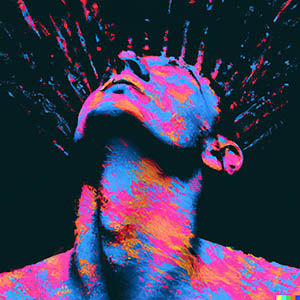Motion-color synesthesia
Motion-color synesthesia is a rare neurological condition in which an individual perceives colors associated with motion, movement or visual stimulation. This unique form of synesthesia allows people to see colors in response to certain movements or motions. For example, a person may see a bright red color when they see a fast-moving object or see yellow colors when they see slow movements. This type of synesthesia is still a relatively new field of study, and there is still much to be learned about its causes, mechanisms, and effects on the individuals who experience it.

What is Motion-Color Synesthesia?
Motion-color synesthesia is a type of synesthesia that involves a crossing of the senses, causing the perception of color to occur in response to visual movement or motion. In some cases, individuals with motion-color synesthesia may see a specific color associated with a particular type of movement or motion, while in others, the color perception may vary depending on the speed, direction, or intensity of the movement.
For example, some people with this type of synesthesia may see a bright yellow color when they see a slow-moving object, while they may see a dark blue color when they see a fast-moving object. Others may see different colors depending on the direction of the movement; for example, they may see red when something moves to the right and green when it moves to the left.
Causes of Motion-Color Synesthesia
The exact cause of motion-color synesthesia is still unknown, but many researchers believe that it may be caused by abnormal or heightened activity in certain areas of the brain. Some studies have shown that individuals with motion-color synesthesia may have more extensive connections between the parts of the brain responsible for processing visual information and those involved in color perception.
Other theories suggest that motion-color synesthesia may be related to genetics, with certain genes predisposing individuals to this condition. However, more research is needed to fully understand the genetic and environmental factors that contribute to the development of this unique form of synesthesia.
Effects of Motion-Color Synesthesia
While the effects of motion-color synesthesia may vary depending on the individual, many people with this condition report positive experiences associated with their synesthetic perceptions. Some people find that their ability to see colors in response to movement enhances their perception of the world around them, providing a unique and enriching experience.
However, there may also be some negative effects associated with motion-color synesthesia, particularly in situations where the visual stimulation is overwhelming or distracting. For example, some individuals with motion-color synesthesia may find it difficult to focus on tasks that require concentration when there is too much movement or visual activity in their environment.
Additionally, motion-color synesthesia may also impact an individual's ability to accurately perceive and process information in certain situations. For example, a person with this condition may perceive an object moving at a slow speed as being a different color than it actually is, leading to potential misunderstandings or misinterpretations.
Treatment and Management of Motion-Color Synesthesia
As with other forms of synesthesia, there is currently no known cure for motion-color synesthesia. However, many individuals find ways to manage their synesthetic perceptions, often through the use of relaxation techniques, meditation, and mindfulness practices. Some people also find that incorporating their synesthetic experiences into creative outlets, such as art or music, can be an effective way to manage their condition.
In some cases, cognitive-behavioral therapy may also be helpful for individuals with motion-color synesthesia, particularly in cases where their synesthetic perceptions are causing distress or interfering with daily functioning.